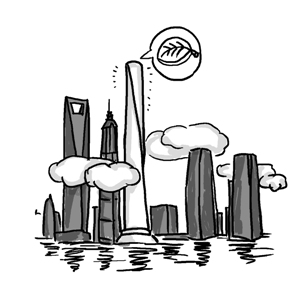Tower sends right signal

Illustration: Lu Ting/GT
The Shanghai Tower in Pudong New Area will open next year. Reaching 632m and stretching 118 stories high, the tower has been dubbed the "world's greenest skyscraper." But in a city where air pollution is a growing problem, can such an environmentally friendly structure have much of an impact?
Air pollution isn't a new problem in Shanghai, and it's getting worse. It brings with it a host of serious health implications. It also has a negative economic impact, as workers take more sick days and international companies find it harder to attract foreign staff to postings here. A 2013 survey conducted by the American Chamber of Commerce indicated that 48 percent of executives in 365 international companies were not prepared to relocate to China because of pollution.
It may seem that a thriving economy and virtually smog free air cannot coexist, but the Shanghai Tower may show this to be wrong.
Having won an LEED Gold Award and China Green Building Three Star Award for its environmentally friendly design, the tower has its own wind turbines to generate renewable energy and a sophisticated "second skin" for insulation, which keeps the interior temperature comfortable throughout the year.
The striking 120-degree twisting top will decrease wind loads by up to 24 percent during typhoons, while locally sourced-materials, fit for recycling, have been used where possible.
One-third of the building will be "sky gardens." These recreational areas will act as buffer zones where indoor air will be vented from the building to create a natural form of air conditioning.
Meanwhile, the Tower's design allows for plenty of natural light, reducing the need for electric lighting during the day. A total 43 sustainable technologies will power the structure, reducing its carbon emissions by an expected 21 percent.
"It's the greenest super high-rise building on earth at this point in time," Dan Winey, Asia managing principal for Gensler, the architectural firm behind Shanghai Tower, told the Financial Times in November.
The Shanghai Tower has all the right ingredients to be both a lucrative and environmentally friendly structure, but building any skyscraper requires huge amounts of energy. To claim the tower is a major green-footed step forward for Shanghai seems far-fetched. However, it could mark the start of a fundamental shift in China's approach to advancement and growth in the 21st century.
"It's an opportunity for the government to make a progressive statement to the world about sustainable strategies and they are also looking at this tower to be a model for future developments in China," Grant Uhlir, principal of Gensler, told Chinadialogue in October.
While Uhlir's message seems logical, in practice the tower will be home to a luxury hotel, shops, offices and a metro station, meaning the building will still use vast quantities of energy every day. Merely forming its foundation required a fleet of trucks to pump concrete into the ground for 63 hours.
As the city's population continues to grow, space and housing will be increasingly limited. Arguably the most cost effective and sustainable way for a city to tackle a lack of homes is by building upwards. While just one relatively environmentally friendly tower is going to do nothing in real terms to reduce emissions and energy use, the example it sets means we will hopefully see more consideration for the environment in future building projects.